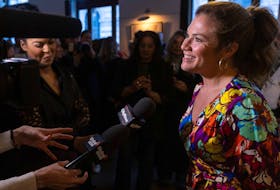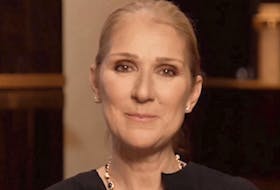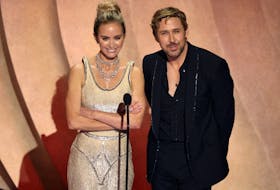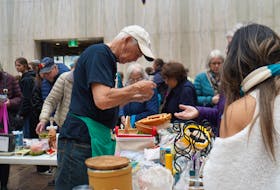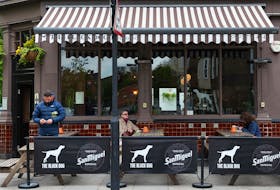TORONTO - When the world marks the 40th anniversary Monday of man's first landing on the moon, it will be paying tribute to American ingenuity and what arguably is one of that country's finest moments. But it was one of Canada's proudest moments, too.
Many Canadians are unaware that a group of their countrymen working at NASA was instrumental in delivering the Apollo 11 astronauts to the lunar surface on July 20, 1969 - and getting them safely back home to Earth.
In fact, even before Neil Armstrong's booted feet stepped onto the rocky, crater-pocked surface of the moon, Canadian-made legs on the lunar landing module had settled into the satellite's dust first. The splayed legs were produced from light-weight aluminum using a compressible honeycomb design by Quebec's Heroux-DEVTEK, which won the NASA contract.
The landing module was primarily designed by Sarnia, Ont.-born Owen Maynard, an engineer who worked on the famed Avro Arrow before the federal government under Diefenbaker abruptly cancelled the supersonic jet program in February 1959.
Maynard and about 25 others laid off from Toronto's A.V. Roe aircraft on what was dubbed Black Friday were quickly snapped up by the Americans to help them fulfil President John F. Kennedy's 1961 edict that the country land a man on the moon within the decade.
"Canadians contributed a massive amount to the space race and Apollo," says Robert Godwin, a curator for the Canadian Air and Space Museum in Toronto that houses a full-scale replica of the Arrow.
"Not meaning it to be a derogatory remark, but the Americans benefited greatly from the demise of the Arrow," he says. "All of these genius engineers ended up going to help put men on the moon."
Godwin, who also writes and publishes books on space, said Maynard was among the first - if not the first - to sketch a design for a lunar lander that "ultimately looked very similar to what they actually built."
"He drew this four-legged, spider-like landing craft, that ... used the bottom half as a launch platform to come back (to the orbiter) again."
Maynard, who died in 2000 at age 75, was promoted to chief of systems engineering for the Apollo program and stayed at NASA until after the Apollo 12 crew completed its moon mission in November 1969.
The work was a piece of heaven for the Second World War RCAF pilot, but also a huge responsibility, says his son.
"Even as a young kid I could figure out, here's an engineer that's getting to work on the space program, the brand-new stuff, the new frontier," says Ross Maynard, 57, who recalls moving as a seven-year-old to Langley, Va., where his father began working on spacecraft, before settling more permanently near Houston.
During the moon landing, then 17-year-old Ross says he was virtually "hugging the television ... holding my breath."
"As a person who had figured out by that time that my dad had a lot to do with the lunar module, I was on pins and needles. Well I was on pins and needles from liftoff to splashdown."
Yet the walkabout on the moon by Armstrong and Buzz Aldrin "didn't really do a thing for me," he says. His mind was fixated on whether the astronauts would be able to successfully blast off from the surface and rendezvous with the command module orbiting the moon under the hand of pilot Michael Collins.
It seems that was his father's biggest concern too.
"During the walking on the moon he was actually at home," remembers Ross Maynard. "He comes out of the bedroom with his dark blue house coat on ... and I said. `Oh, they're getting ready to walk on the moon,' and he looked at the TV for a couple seconds, and he said, `Yeah, they are.' And then he went and ate breakfast, went back to his bedroom, got dressed and went back to work."
"They were probably so far ahead of, `OK we're going to walk, we're going to walk, there's not going to be a problem with walking. Now what's the next problem going to be?"'
"`We already did that' in his mind. He's now farther ahead in all the things that could go wrong in terms of getting them back in the thing, getting the pressure back up and ready to fly off. And then they've got to find the Columbia (the command module)."
Ross Maynard, who worked as an industrial chemist in the U.S. and now farms a property south of Peterborough, Ont., says his father and the other Canadians he worked with at NASA got some media attention in Canada at the time and he later received an honorary doctorate from the University of Toronto.
"He was a very nice guy, my dad ... And being such a nice guy, and having this tremendous pressure on him and his performance, with basically lives at stake, was a huge contribution but also a huge burden on him."
"I asked him one time if he thought he would have liked to have worked on the space shuttle, and he looked at me and he said: `It would have killed me.' So he knew his limits. So once that Apollo 12 was done, he was on his way."
Still, says Godwin of the Air and Space Museum, the contribution to the moon landing by Maynard and other Canadians - and to aeronautics in general - should be celebrated by their country. On Monday, the museum will honour Maynard with a posthumous award as part of an event to mark the moon landing anniversary.
"Very few do know about it," says the British-born Godwin, who has lived in Canada for 31 years. "I think it has a lot to do with the Canadian psyche in some respects. Canadians are not very outspoken, I've found."
"I think that Canadians are very low-key about their accomplishments and they shouldn't be, because Canadians have done things that people in the rest of the world have never done."
Canadians played integral part in getting Apollo 11 crew to moon - and back
None
STORY CONTINUES BELOW THESE SALTWIRE VIDEOS
Sustainable Wines for Earth Day | SaltWire #reels #EarthDay #shorts


